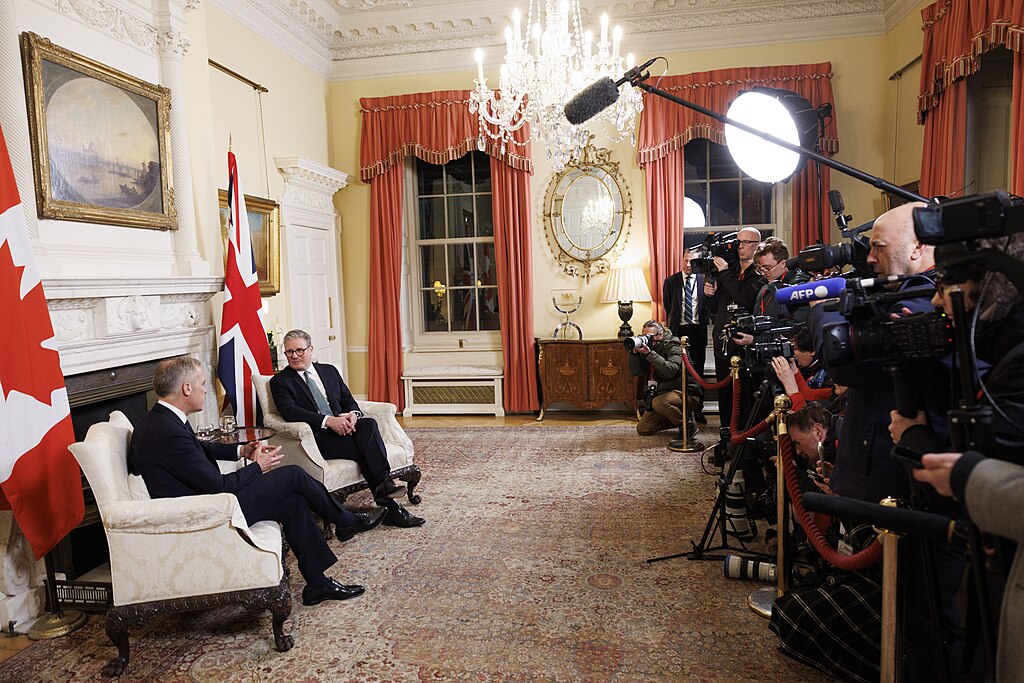By Érick Duchesne, Université Laval and Mehdi Abbas, Université Grenoble Alpes (UGA)
Canada is caught between two giants with diverging interests, the United States and China. It’s also grappling with the repercussions of the trade and geopolitical tensions that are pitting these two powers against one another.
On one side, Canada has an unpredictable and less reliable American neighbour, and on the other, an uncompromising China, which regularly imposes economic sanctions on Canada’s strategic agricultural products, including soybeans and pork.
This exposes the geopolitical vulnerability of Canada, which is too dependent on its traditional partners.
As a political scientist and an economist, respectively, who specialize in international political economy, we study economic multilateralism, geo-economics and transatlantic relations. This has led us to consider some concrete measures that could strengthen ties between Canada and the European Union.
Wavering American influence
President Donald Trump’s second term has signalled the decline of the United States as a moral leader of the world. By withdrawing from an increasing number of multilateral agreements, displaying admiration for authoritarian regimes and reviving unfounded accusations of electoral fraud, the Trump administration has weakened America’s reputation as a democratic model and trusted player on the international scene.
Transatlantic tensions have intensified as a result of Trump’s repeated threats to pull the U.S. out of NATO, a move that calls into question the security basis of the alliance. In addition, the stalemate in trade negotiations between Washington and Brussels illustrates how differences over international trade rules and the protection of strategic industries are now growing.
China is not a credible alternative
Although China is in the midst of economic ascent, the country does not represent a credible alternative for Canada in the face of the U.S. withdrawal. Together, the coercive diplomacy of Chinese authorities, the country’s lack of transparency and internal tensions, particularly financial (its real estate sector is in great difficulty), limit China’s appeal as a world leader.
Since the 2018 arrest of Huawei’s chief financial officer Meng Wanzhou in Vancouver, carried out at the request of the United States, Chinese-Canadian relations have deteriorated considerably. In retaliation, China arrested two Canadian citizens, Michael Kovrig and Michael Spavor, sparking a major diplomatic crisis.
Since then, mistrust has deepened, fuelled by persistent tensions around cybersecurity, foreign interference and trade restrictions, but also by the recent execution in China of four Canadian citizens convicted of drug trafficking.
EU: Economic, strategic alignments
In this global context, the European Union is increasingly faced with the need to build strategic autonomy, both militarily and economically, in order to guarantee its sovereignty and long-term stability.
To become a stabilizing force, the European Union must meet three conditions: it must have sufficient economic power, demonstrate the political will to act collectively and be perceived as a legitimate and credible entity by other democracies. From this perspective, Canada appears to be a natural and reliable partner.
On the commercial front, the foundations for a stronger partnership are already there.
The European Union is Canada’s second-largest trading partner after the U.S. In 2023, the combined trade in goods and services between Canada and the EU reached a value of CA$157.3 billion. The Comprehensive Economic and Trade Agreement (CETA), in force since 2017, has eliminated 98 per cent of customs duties between the two partners, which has promoted sustained growth in trade.
Thousands of subscribers already receive The Conversation Canada’s daily newsletter. And you? Subscribe today to our newsletter to better understand today’s major issues.
But further integration would offer full access to the European single market, harmonization of standards and synergies in key sectors: green technologies, artificial intelligence, pharmaceuticals and cybersecurity. It would also give Canada access to major European programs such as Horizon Europe, a research fund of 95.5 billion euros (nearly $148 billion in Canadian dollars).
Furthermore, Canada possesses natural resources that are crucial to the European energy transition: lithium, cobalt and nickel. Enhanced collaboration would ensure a secure and sustainable supply to Europe while promoting strategic industries on both sides of the Atlantic.
A transatlantic pillar
In geopolitical terms, the EU is undertaking a major change in direction.
It is developing a common defence policy, supported by a budget of 800 billion euros (CA$1,237 billion) and reinforced by the Draghi report, which calls for enhanced strategic autonomy, including the consolidation of a defence industrial and technological base.
Germany, breaking with its tradition of budgetary restraint, is investing heavily in its military capabilities. Europe no longer simply wants to defend itself alongside the U.S., it wants to emancipate itself from an unpredictable America.
Canada, a staunch NATO ally and supporter of rules-based international order, could play a role in the coalition of the willing — a plan to support Ukraine adopted after the London Summit in March 2025 — within the EU, without waiting for the unanimous agreement of the 27 EU member countries.
Canada’s participation would make it possible to strengthen the coherence and effectiveness of European action on the international stage.
Moving towards membership?
The idea of Canada joining the European Union is ambitious, but it follows a certain logic.
Canada meets the Copenhagen criteria (rule of law, democracy, market economy) and shares the fundamental values of the EU. The main obstacles would be of a technical or political nature: geographical distance, the need for Canada to align its laws and regulations with all European standards (the Community Acquis) and to adapt its agricultural supply management system to European internal market rules.
But Canada doesn’t necessarily need to aim for immediate formal membership. A more flexible path could be a close strategic partnership, inspired by the Norwegian or Swiss models but adapted to Canadian realities.
Such a partnership could include enhanced access to European markets, participation in joint research, defence or energy transition projects and increased co-ordination within multilateral institutions.
The objective would not be strictly economic, but political and symbolic: to affirm a common commitment to democracy, international co-operation and respect for the global legal order.
A strategic turning point for Canada
In a changing world, Canada can no longer rely solely on its North American anchor. It must diversify its partnerships and strengthen its strategic autonomy. The transatlantic link, if rethought in a modern and flexible way, can offer this alternative.
A rapprochement with Europe could also help revitalize the democratic debate in Canada and strengthen both national cohesion around a common project and its ability to face future crises, whether economic, security or climate related.
The time has come to start this discussion, which should not be considered a dream, but an exercise in strategic foresight. Canada’s future may well be shaped, in part, on the other side of the Atlantic.
Érick Duchesne, Professeur, Département de science politique, Université Laval and Mehdi Abbas, Maître de conférence, Université Grenoble Alpes (UGA)
This article is republished from The Conversation under a Creative Commons license. Read the original article.






